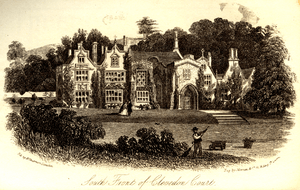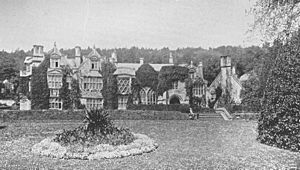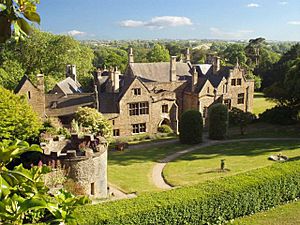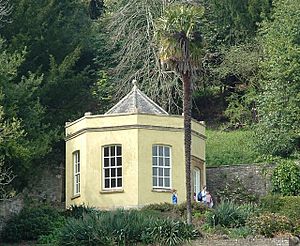Clevedon Court facts for kids
Quick facts for kids Clevedon Court |
|
|---|---|
 |
|
| General information | |
| Town or city | Clevedon |
| Country | England |
| Coordinates | 51°26′25″N 2°49′56″W / 51.4402°N 2.8321°W |
| Completed | 14th century |
| Client | Sir John de Clevedon |
Clevedon Court is a historic manor house located on Court Hill in Clevedon, North Somerset, England. It was first built in the early 1300s. Today, the house is owned by the National Trust, a charity that protects historic places. It is recognized as a Grade I listed building, which means it's a very important historical site.
The house has grown and changed a lot over hundreds of years. The oldest parts, like the great hall and chapel, are from the 14th century. More sections were added around 1570, and its look was updated. Even more changes happened in the 1700s when the Elton family owned it. The house became part of the National Trust in 1960. The Elton family still lives there, and visitors can explore this amazing place. The gardens around the house are also very special and are listed as Grade II* on the National Register of Historic Parks and Gardens.
Contents
The Story of Clevedon Court
Most of Clevedon Court was built in the early 1300s by Sir John de Clevedon. Some people think it might even be on the site of an old Roman building! The house still has parts from the 1200s, which are even older. It was built about two miles from the local church of St Andrew, which is by the coast.
After the Norman Conquest in 1066, the land of Clevedon was given to Matthew de Mortagne. Sir John de Clevedon might have been related to him. Because the church was far away, the manor house had its own chapel. It was dedicated to Saint Peter in the 1320s. Clevedon Court has changed a lot over the centuries, with new parts added almost every 100 years. But it still looks like a classic medieval manor house.
Sir John de Clevedon's daughter, Katherine, started England's very first free school. The de Clevedon family line ended in 1376. The manor then passed to the Wake family, who were the local lords until 1630. John Wake added a new west wing to the house in the late 1500s. In 1630, the manor was sold to Sir John Digby. His lands were taken during the English Civil War but were returned later. In 1709, Abraham Elton, a merchant from Bristol, bought the house.
The Elton Family's Influence
The Eltons were a very important family in Bristol. Abraham Elton was a sheriff and mayor of Bristol. He also became a member of Parliament and was given the special title of baronet in 1717. The family's wealth came from various businesses, including copper and brass mining in the Mendip Hills.
Several more Sir Abraham Eltons followed. Sir Abraham Elton, 2nd Baronet, and his son, Sir Abraham Elton, 3rd Baronet, also served as sheriff and mayor of Bristol. The second Baronet was also a Member of Parliament for Taunton. The third Baronet faced financial difficulties. In 1761, the estate went to his brother, Sir Abraham Isaac Elton, 4th Baronet. He made big changes to the house and gardens in the popular Gothic revival style.
His son, Sir Abraham Elton, 5th Baronet, inherited the title in 1790. He was a church minister and supported Hannah More, a social reformer. His second wife, Mary, made more changes to the house in the early 1800s. She also helped improve the town of Clevedon, including starting a school. One of the modern primary schools in Clevedon is named after her.
The line of Abrahams ended in 1842 when Sir Charles Abraham Elton, 6th Baronet, took over. Sir Charles was a writer. His sister Julia was married to the historian Henry Hallam. Their nephew, Arthur Hallam, is buried in the Elton family vault. Arthur Hallam is the subject of a famous poem by Alfred Tennyson, called In Memoriam A.H.H.. Tennyson visited Clevedon Court in 1850. William Makepeace Thackeray, another famous writer, also visited. Clevedon Court was the inspiration for the house "Castlewood" in his novel The History of Henry Esmond.
Sir Arthur Elton, 7th Baronet, became the owner in 1853. Like his father, he was a writer. He worked to improve the town of Clevedon, setting up a library and building a hospital. All Saints' Church, near the Court, was built in 1860 because Sir Arthur wanted it. He also added parts to the Court itself. A fire in 1882 badly damaged the West Wing of the house. It was rebuilt by architect C. E. Davis. During this work, the old chapel was found again. It had been hidden for a long time.
Sir Edmund Elton, 8th Baronet, inherited the estate in 1883. He was a keen volunteer firefighter and an inventor. He also became a famous potter. He set up his "Sunflower Pottery" in the Court grounds with a local boy named George Masters. Their "Elton ware" pottery became very popular, especially in America. Their pottery often has bright colors, raised flower designs like Art Nouveau, and sometimes shiny metallic finishes.
Sir Edmund's son, Sir Ambrose, took over in 1920. His son, Sir Arthur, was a pioneer in making documentary films before, during, and after the Second World War. He inherited the title in 1951. In 1960, the house was given to the National Trust. This helped pay for death duties. The Victorian west wing was taken down to save money and make the house look more like its medieval design. Sir Arthur passed away in 1973. His son, Sir Charles, then became the owner. The Elton family still lives at Clevedon Court, and it is open for people to visit.
The Architecture of the House
Clevedon Court faces south, with Court Hill behind it. The oldest parts, like the great hall, passages, porches, and chapel, are from the early 1300s. The chapel windows have beautiful stone patterns. These parts were likely finished by 1322. The 14th-century building also included older structures, like a small four-story tower from the 1200s. The room that became the 14th-century kitchen was probably an even earlier hall.
During the late medieval period, a two-story toilet tower was added at the back of the house. Around 1570, a large west wing was built. This would have greatly changed how the Wake family lived there. At the same time, the front of the house was updated with new windows in the "Elizabethan" style.
Not much is known about building work in the early 1700s, which might have just been repairs. But in the 1760s and 1770s, big changes happened. The great hall roof was replaced, and a new Gothic-style window was added. The west wing was also redesigned in a "Chinese Gothic" style.
Sir Arthur Elton (7th Baronet) started updating the house before 1850. In the 1860s, he made major changes. The west wing was made bigger and redesigned with an Elizabethan look. Changes were also made to the east end, where the servants lived. The fire of 1882 destroyed much of the western part of the house. When it was rebuilt, an even larger west end was constructed. Sir Arthur made sure to keep its Elizabethan south front. Around 1912, the great hall window was changed again to have a square top, in the Elizabethan style.
In the late 1950s, when the National Trust took over, the Victorian west wing was removed. Many smaller buildings from the 1700s and 1800s at the back were also taken down. The new west front was given a stone look and included the Elizabethan south front.
Outbuildings and Towers
In the grounds of Clevedon Court, there's a small tower with battlements that dates back to medieval times. Its original purpose is unknown. It's next to a large wall that might also be from the 1200s. Other garden walls are very old, mostly from before 1730, when the stables were built. All the other buildings, like the lodge at the south entrance (built in 1851), are from the Georgian or Victorian periods. The eastern barn looks medieval because it uses stones from an older medieval barn that used to stand in front of the house.
An old picture of the court shows a building called Wake's Tower on Court Hill. It was on a map from 1570 but was taken down before 1738. Towers like this were popular in Elizabethan times. They were often used as lookouts or summer houses. A summerhouse was built on the same spot later, but it was also in ruins by the early 1800s.
Inside Clevedon Court
The biggest room in the house is the great hall. This was originally the main dining room. The screens passage next to it led from the service rooms to the hall. The staircase on the north side of the hall was added in the 1700s. The state room on the first floor was damaged by fire in 1882. The wooden panels around its fireplace came from the Eltons' previous house in Queen Square, Bristol.
The chapel on the first floor has a rectangular window with beautiful stone patterns. This window is a main feature on the front of the house. The stained glass in the window was added after the 1882 fire. The justice room has been used for many things. It gets its name because it was where the manorial court met until the 1700s. The house displays many family portraits and other paintings. It also has collections of Eltonware pottery, Nailsea Glass, and old pictures of bridges and railways.
The Beautiful Gardens
The gardens of Clevedon Court are very special and are listed on the National Register of Historic Parks and Gardens.
The gardens are located at the bottom of Court Hill. They face south and are protected from the winds coming off the Bristol Channel. The front lawns gently slope down to the perimeter wall. Behind the house, the garden is carved into the hillside with a series of terraces. These terraces rise steeply up to meet the woodland above. The famous garden designer Gertrude Jekyll once said that the garden has "One of the noblest ranges of terrace walls in England."
While an old record from 1389 mentions two gardens, no one knows exactly where they were. We also don't know when the terraces were built. However, the basic design we see today was definitely in place by about 1730. Later in the 1700s, the space behind a large wall was filled in to create the top terrace. This terrace offers wide views across the valley to the Mendip Hills. The Octagon, a garden building, was built around the same time. A more rustic summerhouse was also built, facing the Octagon across a long grassy path. The lower wall was later covered with pink bricks, which were also used to build steps below the Octagon. The garden still largely looks like it did in the 1700s. Small ponds and fountains were added in the 1800s. The hillside behind, which was once open, is now covered with thick woods. A single rose arbour from the Edwardian garden was replaced in 2009. This marked 300 years of the Elton family living at Clevedon Court.
We don't know much about the plants from the mid-1700s. However, there is a twisted black mulberry tree in front of the house that was described as very old back in 1822. Drawings and photos from the 1800s show more detailed and fancy flower beds. These were removed in the 1960s. Today, the garden has a more natural style, highlighting its architectural features and long walls. This style is also easier to take care of. In recent years, native wild plants have been allowed to grow alongside rare and exotic plants. Gardeners are always thinking about how to combine different textures and colors of leaves. The lower garden, in front of the house, now feels like a small arboretum with several beautiful trees. A splendid catalpa tree (an oriental plane tree) stands out here. The grass around it is left uncut in spring, allowing camassias and bluebells to create a lovely display.
Like many English gardens, this one looks its best in May and June. That's when the magnolias are blooming and luxurious plants like peonies and alliums are in flower. There's an ongoing effort to add plants that look good throughout the year or are at their best in late summer. Now, there are many types and colors of lavender, and lots of agapanthus, crinum, nerines, and day lilies. You can also find rare plants like a Heptacodium and an Arbutus menziesii.
See also
- Grade I listed buildings in North Somerset
- List of National Trust properties in Somerset







